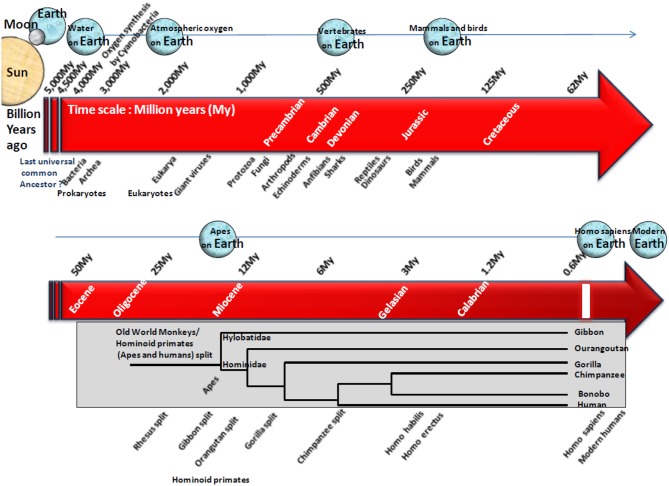Figure 2.
Schematic representation of the origin of life on Earth and simplified phylogenetic tree illustrating the evolution of hominoid primates. Earth is expected to have formed roughly 4.5 billion years ago according to radiometric dating. The most common hypothesis suggests that life arose gradually from inorganic molecules to more complex structures able to self-replicate. On the time scale of life evolution on Earth, microorganisms and NHP are at the other end of the spectrum. Microorganisms were the earliest self-replicating structure present billion years ago whereas hominoid primates are the latest, with an estimated appearance 23 My ago. Cyanobacteria are expected to have first contributed to the presence of atmospheric oxygen on Earth. Then, microorganisms have shaped the world of life during million of years controlling processes essential to life of complex organisms. Almost 15,000 bacteria species have been characterized to date (40), yet they represent a small part of the estimated 10 million bacteria species that are expected to colonize the Earth (47). More than 2,000 viral species have also been characterized (41). The recent proposal of a fourth branch named “TRUC” (for Things Resisting Uncompleted Classifications) a new branch in species evolution that includes giant viruses, has challenged the previous evolution tree that discriminated among Archea, Bacteria, and Eukarya (42). The divergence between Eubacteria and Eukaryotes was >3.5 billion years ago (48). Indeed earliest eukaryotic cells are expected to have got their cytoplasm from Eubacteria, their nucleus from Archebacteria, and their mitochondries from an aerobic prokaryote (49). Old World monkeys (OWM, referring to Africa and Asia) and hominoid primates (apes, humans), share a common ancestor. The divergence of OWM and hominoid primates was estimated 23 million years (My) ago at the Oligocene-Miocene boundary, although estimating divergence remains a difficult task since the molecular clock in OWM (rhesus monkeys, pig-tailed macaques, bonnet macaques, cynomolgus monkeys, colobus monkeys, proboscis monkeys, African green monkeys, baboons, and langurs), apes (gibbons, orangutans, gorillas, chimpanzees, bonobos), and humans, seems to run at a lower rate than for other mammals (50). It was recently claimed that human had diverged 12 My ago from chimpanzees and 15 My ago from gorillas (51), whereas previous reports estimated that human had diverged from chimpanzees (Pan troglodytes and Pan paniscus) 6 My ago, from gorillas (Gorilla gorilla and Gorilla beringei) 6.5 My ago, from orangutans (Pongo pygmaeus and Pongo abelii) 12 My ago from gibbons 15 My ago and from rhesus monkeys (Macaca mulatta) 21 My ago, respectively (50). Our first ancestor, Sahelanthropus tchadensis, lived in Africa 6 My ago, whereas Homo sapiens emerged much later, 0.15 My ago. Subsequently, Homo sapiens has spread and evolved through the entire planet while being subject to natural selection. A study of short tandem-repeat Alu polymorphism indicated that non-African populations have high frequencies of Alu(+) allele, whereas African populations have low frequencies of the Alu(+) allele. In chimpanzees and gorillas, only the Alu(–) allele was observed, supporting the hypothesis that Alu-insertion occurred after the divergence of human and great apes (52). At most the hosts are genetically close at most the risk of pathogen transmission is high.

